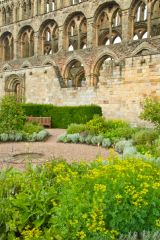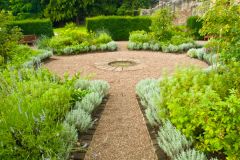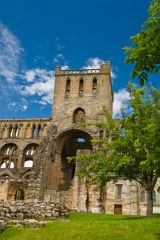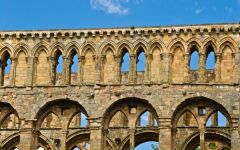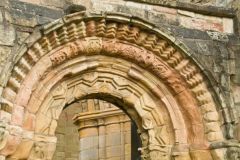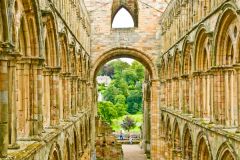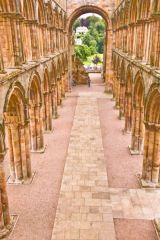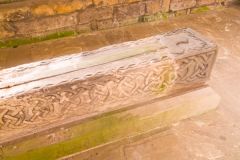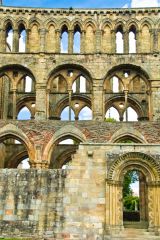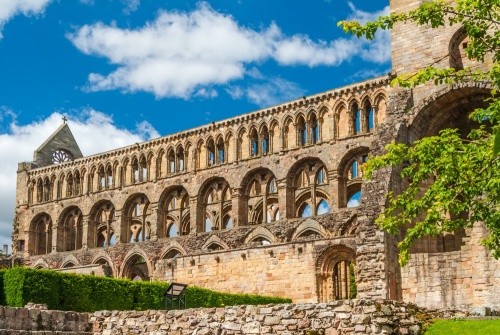
There was a minster church at Jedburgh as early as the 9th century, but in 1138 King David I granted land here to a group of Augustinian canons from St Quentin, in France. It seems likely that the Augustinians continued using the earlier church until their own imposing church was sufficiently complete to begin holding services by 1174, about 20 years after the priory was raised to abbey status.
Unlike the Cistercians, the other great monastic order in Lowland Scotland and northern England, the Augustinians did not seek out remote places to build their priories. Rather they built close to important political centres.
This was a deliberate policy that allowed the Augustinians to influence government and act as advisors to rulers, but also to minister directly to the local population. Augustinian canons often acted as parish priests, and for this reason, they tended to be more popular than more reclusive orders.
There was a royal palace at Jedburgh, and the abbot was a frequent advisor to Scottish rulers. Alexander III married Yolande de Dreux at the abbey church in 1285. According to a rather convenient legend, a spectral figure appeared at the wedding and prophecied the king's imminent death. Sure enough, Alexander suffered a fatal fall from his horse the following year. The coronation of Malcom IV also took place here.
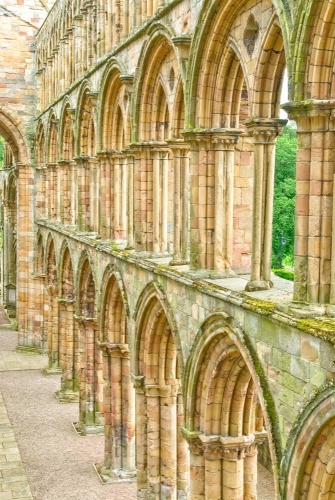
The original abbey church ended in a semi-circular apse, common in Europe but seldom seen in Britain. The apse was rebuilt around 1220, and by the mid-13th century the church was complete. A north transept was added in the late 15th century, when a beautiful rose window was inserted over the west door.
Life was not always peaceful for the canons of Jedburgh; the border country between England and Scotland was criss-crossed by armies throughout the medieval period. The canons had to flee during the 14th-century Wars of Independence under Robert the Bruce. There were further attacks in the 15th century, and again during Henry VIII's 'rough wooing' in the 16th century.
The finish came in the Scottish Reformation of 1560 and Jedburgh fell out of use. Building stones were robbed for other purposes, and the ancillary buildings gradually disappeared under mounds of turf. The striking abbey church, however, survived amazingly intact, and this is the most compelling feature of the abbey today.
After the Reformation a Presbyterian church was created out of the abbey church transepts and crossing. In 1671 another new church was created at the west end of the nave. The parish church was removed entirely from the abbey after a collapse of the crossing arch in 1743.
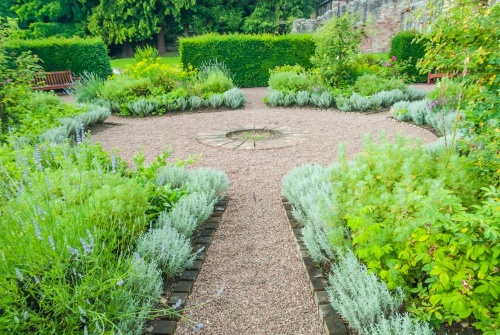
Little beyond foundation walls remains of the monastic buildings that stood on the slope between the abbey church and Jed Water, but the church is in a remarkably good state of preservation. The nave and north transept stand to their full height, exposing wonderful clerestory arcades looking down upon unbroken avenues of Romanesque columns, and the early 16th-century tower is almost untouched by time.
The Romanesque elements are rare in Scotland, and the contrast of the thick, rounded 12th century columns of the east end make a wonderful contrast with the more delicate Gothic architecture of the nave.
Excavations on the site have unearthed numerous artefacts, including an 8th-century Anglian shrine, and a beautiful ivory comb made around 1100 AD, plus a Roman altar slab and 9th-century cross-heads and shafts. These are displayed in the visitor centre below the cloister buildings. In the abbey church is a 12th-century tomb cover that may be that of John, Bishop of Glasgow, who was buried here in 1148.
Romanesque choir and transepts
Gothic nave
12th-century Jedburgh Comb
12th-century west front
Restored cloister garden
Visiting Jedburgh Abbey
It is hard to miss the abbey; it towers over the main road as you drive through the town. There is a small parking and a small visitor centre and shop. As of this writing, the abbey is open daily except for Christmas and Boxing Day. Free entry to Historic Scotland members (as well as those with associated membership passes like Cadw and English Heritage).
I loved the abbey; it is rare to visit a medieval monastery where the church stands to its full height as it does here, and the architecture is absolutely wonderful. The view down the nave from the tower is quite exceptional.
While you're in Jedburgh don't miss Mary, Queen of Scots House, a short stroll from the abbey.
About Jedburgh Abbey
Address: Abbey Bridge End,
Jedburgh,
Borders,
Scotland, TD8 6JQ
Attraction Type: Abbey
Location: On the A68/B6368
Website: Jedburgh Abbey
Historic Scotland
Location
map
OS: NT650204
Photo Credit: David Ross and Britain Express
HERITAGE
 We've 'tagged' this attraction information to help you find related historic attractions and learn more about major time periods mentioned.
We've 'tagged' this attraction information to help you find related historic attractions and learn more about major time periods mentioned.
Historic Time Periods:
Find other attractions tagged with:
12th century (Time Period) - 13th century (Time Period) - 15th century (Time Period) - 16th century (Time Period) - 8th century (Time Period) - 9th century (Time Period) - Augustinian (Historical Reference) - Henry VIII (Person) - Mary, Queen of Scots (Person) - Medieval (Time Period) - Reformation (Historical Reference) - Robert the Bruce (Person) - Roman (Time Period) -
NEARBY HISTORIC ATTRACTIONS
Heritage Rated from 1- 5 (low to exceptional) on historic interest
Mary, Queen of Scots Visitor Centre - 0.1 miles (Museum) ![]()
Jedburgh Castle Jail and Museum - 0.3 miles (Museum) ![]()
Ferniehirst Castle - 1.4 miles (Historic House) ![]()
Waterloo Monument - 3.7 miles (Historic Building) ![]()
Mertoun House Gardens - 7.3 miles (Garden) ![]()
Dryburgh Abbey - 7.9 miles (Abbey) ![]()
William Wallace Statue - 8.5 miles (Historic Building) ![]()
Smailholm Tower - 8.9 miles (Historic Building) ![]()
